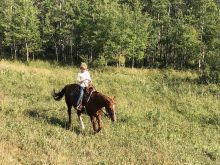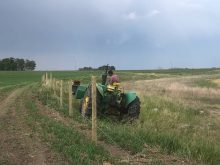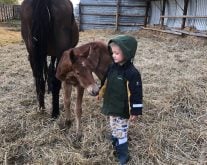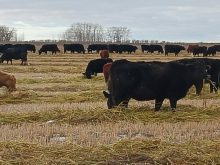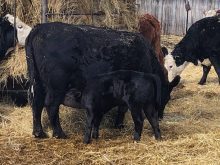May 20
Sunday morning I did chores early and got gates ready for moving cattle so we could brand and vaccinate. AWOL Alice was out again, but grazing in the buffer zone between the two electric fences, which made it easy to get her back in.
Charlie came to help brand, and Dani’s friends Jack and Roger. We brought the cows and calves in, sorted the calves off and locked them in the sick barn, then vaccinated the cows. Charlie caught their heads, Jack worked the tail gate, Dani and Roger kept the cows coming up the alley to the squeeze chute, I vaccinated, and Andrea put insecticide ear tags in.
Read Also

Harvest wraps up and fall work begins
At the Eppich famly ranch in western Saskatchewan, the fall harvest was successful with few breakdowns, cows and calves have been sorted and a new tractor has arrived
Afterward, we did the bulls, then the calves. Dani and Roger brought the calves into the little holding pen from the sick barn, a few at a time, and pushed them one at a time into the calf table chute where I caught their heads, Charlie tipped the table and I vaccinated while Andrea clipped the area for the brand. She branded while Charlie held the tail straight up to immobilize the calf for branding, then Andrea put a fly tag in the ear. We took the cows and calves back to their field and brought the yearling heifers to the corral.
Lynn parked the tractor in front of the chute so we could tie a rope to the hay fork. After we vaccinated each heifer we put a halter on and stretched her head and neck up a bit so Andrea could put in the brisket tags — their permanent number.
Tuesday was Lynn’s birthday; he turned 79. All his sisters called to wish him a happy birthday. That was also the day Christopher had an appointment with a heart specialist in Missoula, Montana, to have his heart murmur checked, but he had such a bad cold and cough that Emily rescheduled the appointment; it’s postponed until August.
May 31
Last Tuesday we finally let the cows out to pasture. They are so hungry for green grass — tired of eating hay! Andrea harrowed the pasture we took them from, so we can start irrigating it; hopefully it will grow quickly so we can graze it in about a month.
Andrea helped Lynn take the hay fork off the tractor and put on the loader bucket so he could haul a bunch of big rocks to heifer hill to put around the ditch culvert. Today I helped Andrea create cross fences in the pasture part of the field below the lane, so we can start grazing it in segments.
June 10
Andrea took Christopher with her this evening to change water. He loves taking his little shovel to help irrigate.
June 16
Saturday we moved the cows to the next segment of the pasture below the lane and put up an electric fence to make a corridor so they can come back up to the first segment to drink from the ditch, but fencing them off from the pieces they’ve already grazed, so those can grow back again. The secret to rotational grazing is short grazing periods on many small pieces, and long rest periods so each piece has time to regrow.
Monday the new dirt pad by the corrals had dried out enough that Andrea and Lynn were able to pull the manure spreader in there and park it, and put the turner rake in front of it. This will be a great place to park the machinery so it won’t be taking up space in areas we can graze.
That afternoon Jim, Andrea and Lynn got our little pump running again. We need it for pumping water for cows in our state land pasture which we haven’t used for two years, and haven’t used the pump either. This year we’ll need that pasture.
The next day Dani and Roger helped Lynn load the pump, hoses and long plastic pipe.
June 22
Last Friday Andrea and I moved the cows and calves to their next pasture. Then we rode Dottie and Willow for three hours to check the 320 fence that borders the middle range.
The next day Andrea and I put an electric fence across the orchard and put the heifers and Babe in the lower half. We’ve officially started our breeding season. Emily, AJ and Christopher came out to work on firewood. Jim split wood and AJ and Emily loaded the split wood into AJ’s truck. Christopher helped for a little while, taking some of the blocks of wood to the front of the truck for his mom to stack.
The bull has been doing his job in the orchard and horse pasture; several of the heifers and cows have been bred already.



